Rock stars
2009 Forrest Wood Cup runner-up Mike Iaconelli articulates why rocks are key to locating bass in all seasons
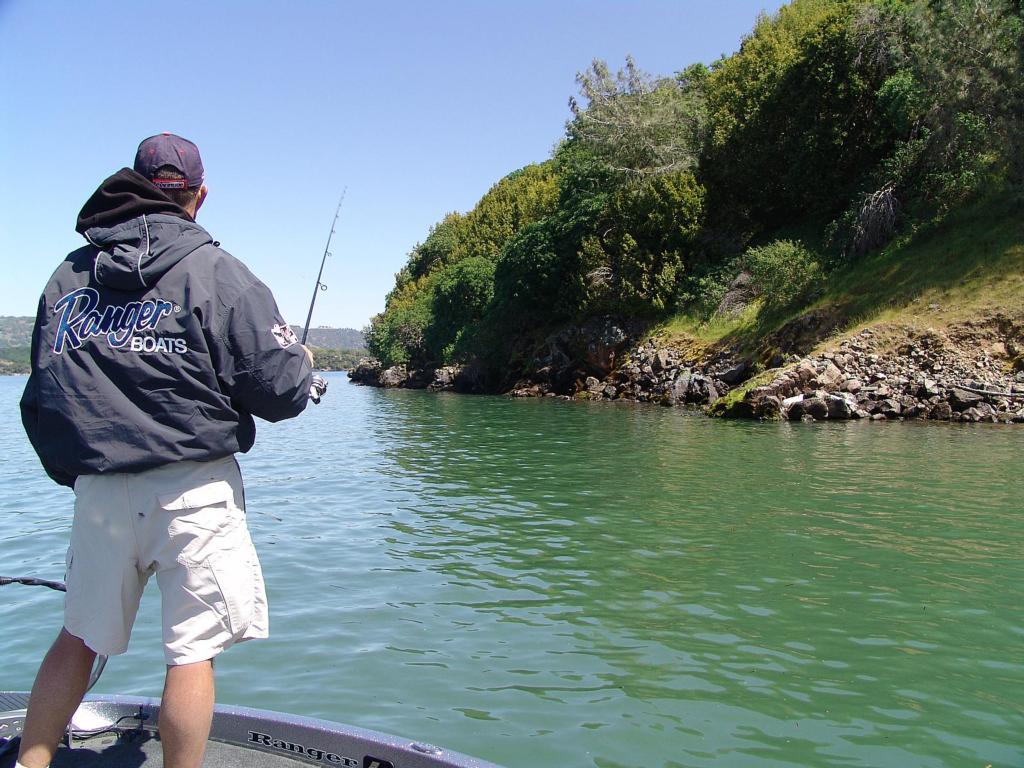
Many bass anglers will be doing hard time in 2011, but don’t worry, we’re not talking incarceration. Rather, it’s the tried and true tactics of finding fish around rocks. Whether we’re talking big ones, small ones, scattered piles, or random ranges – rocks attract bass plain and simple. However, understanding the where, when and why of this truth is the key to maximizing catches.
“Rocks are essential” said FLW pro Michael Iaconelli. “The two key elements of bass fishing are structure and cover. Structure is the actual contour break of the bottom composition and the cover is some kind of physical object. Rock is one of the most common things we see everywhere we go – east coast, west coast, Midwest, clear mountain lakes, lowland reservoirs.”
The attractions are basic, but nonetheless profound: shelter, warmth, ambush and bait aggregation. Complementing natural rocks, solid objects placed by man hold great potential, as well. We’ll save bridge fishing for another time, however, the rubble from fallen structures qualifies here.
Specific types of rock and their formation vary throughout the coast-to-coast range of FLW events, but some basic concepts and tactics stand consistent. Like all piscatorial practices, you’re looking for a starting point – a basic plan from which to expand, explore and innovate. For simplicity, Iaconelli breaks it down with a seasonal outline that anglers can adapt and modify for their specific environments. We’ll start in the cool season and work through a typical year’s movement.
Fall feeding
Autumn finds a lot of the bass in the backs of creeks, patrolling the shallow grass and packing on their winter weight by feeding heavily on the baitfish congregating there. When late fall finds temperatures declining, days shortening and most of the grass dying, the fish know it’s transition time. As they move to their cold season spots in protected deep water coves, rocks play a strategic role.
“All of these changes trigger that late fall movement and as those fish start to slide toward where they’re going to spend their winter. What becomes key are these little rock outcroppings,” Iaconelli said. “These are the stopping points before fish head to their winter patterns.
“They’re heading out from their feeding areas and these rocks are perfect staging areas. As the vegetation starts dying, the bait starts grouping up on these hard places and so do the bass. It’s in this late fall period that I find bass the most ganged up on that hard cover.”
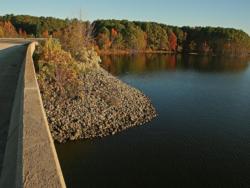 Noting that this is a common scenario in tidal areas like his Delaware River home waters, Ike said he looks for isolated hard spots from a couple feet down to a dozen feet. Natural rock or manmade stuff like old crumbling industrial docks fit this scenario. Riprap attracts loads of late fall fish, as demonstrated by North Carolina State’s Jeff Bumgarner and Will White during their FLW National Guard College Fishing Series Northern Regional victory on Lake Jordan. Bumgarner and White caught most of their fish by cranking the Highway 64 Bridge riprap with Strike King Series 3 baits in a red crawfish pattern.
Noting that this is a common scenario in tidal areas like his Delaware River home waters, Ike said he looks for isolated hard spots from a couple feet down to a dozen feet. Natural rock or manmade stuff like old crumbling industrial docks fit this scenario. Riprap attracts loads of late fall fish, as demonstrated by North Carolina State’s Jeff Bumgarner and Will White during their FLW National Guard College Fishing Series Northern Regional victory on Lake Jordan. Bumgarner and White caught most of their fish by cranking the Highway 64 Bridge riprap with Strike King Series 3 baits in a red crawfish pattern.
Iaconelli also likes crankbaits in late fall. He uses a shallow to medium diver as much for structure location, as for bass enticement. He’ll crank broad areas until he feels his bait deflecting off something solid. The fall fish, he said, are so aggressive that double hookups are nearly expected.
Winter wonders
Knowing that winter fish will relate to the deepest, most vertical break areas in the section of the lake he’s fishing, Iaconelli directs his attention to main lake points, dams, major creek bends, ledges and manmade canals. Finding bass in the cold months can be tough, so locating the hard spots is paramount.
“The wintering areas can be big; they can be 20-, 30-, even 50-acre areas,” Iaconelli said. “You can fish all through it without a bite until you find that hard bottom and boom – it’s like magic,” he said. “In the wintertime, that rock is like a magnet. You have an idea of where they’re going to be and that puts you in the ballpark. But then when you find that rock, it’s the sweet spot.”
Natural rock veins extending from the bank into the water are no-brainers, but for locating the unseen structures – as well as working the obvious ones – Iaconelli likes a 3/8- to ¾-ounce Berkley Gripper Jig in Green Pumpkin with a Berkley Gulp Wicked Wing trailer. This football head design bumps and rolls its way across uneven rock surfaces with minimal snagging.
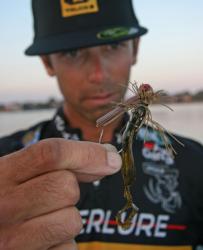 “It’s not a fast retrieve, it’s not a swim, it’s not a stroke – it’s a really slow crawl on the bottom,” Iaconelli said. “I’m feeling the bottom on every cast, just like that crankbait in the fall. Nine times out of 10, what will happen is you’re not feeling anything, not feeling anything and then all of the sudden you feel that crunching. That’s the jig getting into that rock area and boy, before you get away from feeling that rock, you’ll catch a fish.”
“It’s not a fast retrieve, it’s not a swim, it’s not a stroke – it’s a really slow crawl on the bottom,” Iaconelli said. “I’m feeling the bottom on every cast, just like that crankbait in the fall. Nine times out of 10, what will happen is you’re not feeling anything, not feeling anything and then all of the sudden you feel that crunching. That’s the jig getting into that rock area and boy, before you get away from feeling that rock, you’ll catch a fish.”
Because winter bass turn lethargic and cut back on their feeding, the jig’s hefty profile often appeals to fish looking for one easy meal. But when bass shy away from the full package, Ike thins the skirt, snips off a third of the weed guard and uses a smaller trailer. Other productive baits include shaky heads, drop-shots, flick shakes and wacky-rigged stick worms.
Spring fling
During the pre-spawn period, bass basically reverse their fall movement by departing the deep, protected areas and heading back to the shallow creeks and coves to reproduce. Coming off a lean winter diet, the fish will stop on the exterior rocky structures to fuel up before starting their procreation efforts.
“Bass know they have to feed hard before they get to the rigors of spawning,” Iaconelli said. “They know there will be several days when all of their energy will be expended on the spawning ritual, so they start feeding heavy.”
Natural rock certainly presents the bait-gathering scenario spring bass seek, but Iaconelli’s favorite pre-spawn target is the riprap of jetties, causeways and bridges at the mouths of spawning areas. His bait of choice: a 3/8- to ¾-ounce Molix Water Slash spinnerbait with a chartreuse/white skirt and a gold Colorado blade leading a silver willow. Ike rigs a 1/0-2/0 trailer hook and adds a grub trailer in stained water for more vibration.
Casting on a quarter angle to the rock, Iaconelli slow rolls his bait the entire length of the riprap. Bites may occur at any point, but he knows the pot of gold typically sits at the end of this rocky rainbow.
“I’m using that slow-rolled spinnerbait to maintain bottom contact the whole way back,” he said. “The really key area in that cast is where the rock ends and the natural bottom begins. That’s the money spot and slow rolling a spinnerbait lets me find that spot.”
In similar spring scenarios, California angler Scott Green likes to probe rocky points in Clear Lake with 6-inch swimbaits on lead heads. Crankbaits can also be effective here and if you locate a pile of fish on a certain spot, don’t hesitate to pick it apart with a jig.
Summer swelter
After the spawn, deep offshore rock structures will again host big numbers of bass from the post-spawn retreat through the heat of summer. The fish will be following bait schools along rocky breaks and ledges where pinpointing the right spot can deliver huge numbers. The sprawling nature of offshore rocks can make fishing feel like panning for gold – a whole lot of rote repetition until BLING! You locate the treasure.
In 2009, National Guard pro Cliff Pirch showcased this homerun potential by topping the FLW Series National Guard Western Division event with a massive 37-pound, 8-ounce sack that set the record for a single day catch in an FLW Series Western Division event. Working a Berkley Gripper Jig with a Chigger Craw trailer in 15-26 feet did the trick for Pirch.
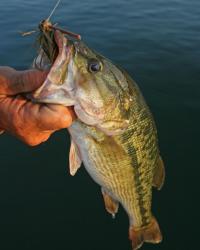 In the deep, offshore spots, Iaconelli upsizes his jigs to ¾- or 1-ounce to hit the targets. Deep diving crankbaits will also deliver here, but Ike notes that past the 25-foot range, it becomes harder to consistently reach the rocks. Deflecting off the solid surface triggers strikes, so make sure you position your boat so your bait can reach maximum depth by the time it passes the structure.
In the deep, offshore spots, Iaconelli upsizes his jigs to ¾- or 1-ounce to hit the targets. Deep diving crankbaits will also deliver here, but Ike notes that past the 25-foot range, it becomes harder to consistently reach the rocks. Deflecting off the solid surface triggers strikes, so make sure you position your boat so your bait can reach maximum depth by the time it passes the structure.
In lakes like Erie and St. Clair, bouncing or “cracking” tubes off the rocks drives summer smallmouth nuts. Offshore rocks mixed with weeds are the ticket, as the vegetation attracts bait, while the hard cover provides ambush points. Drop-shots are not to be overlooked here and where gobies abound, Ohio pro Charlie Hartley recommends matching this invasive hatch.
Another great option for deep rocks is one that makes many anglers groan – until they start catching fish. We’re talking the old standby – the venerable Carolina rig. Truth be told, you can sling this deal a country mile, drag it as deep as you care to fish and trigger some serious strikes when many otherwise effective baits fizzle. Tungsten weights prove strategic in transmitting bottom detail up the line. Fitted with a Berkley Crazy Legs Chigger Craw, a Zoom Baby Brush Hog or an old-school lizard, the C-rig rocks when the fish are hard-headed.
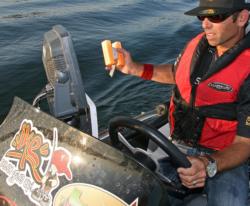 Find it, mark it: Wind, current, boat traffic – many factors can push you past a spot and challenge your repositioning, so try to simplify the operation with a surface level reference. To complement what his bottom indicators show him, Iaconelli marks the sweet spots with anchored floats.
Find it, mark it: Wind, current, boat traffic – many factors can push you past a spot and challenge your repositioning, so try to simplify the operation with a surface level reference. To complement what his bottom indicators show him, Iaconelli marks the sweet spots with anchored floats.
“I keep a couple in the front and a couple in the back,” he said. “Whenever I catch a fish or whenever I see that rise on the graph, I’m going to drop one of these markers. This allows me to get a line on the cast.”
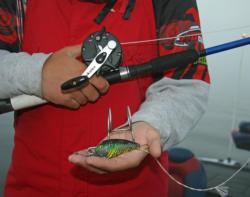 Get it back: A lure knocker stands essential for fishing around rocks, especially rip-rap. The only downside is that when a lure gets so seriously stuck that even the knocker can’t free it, you may have to break off and sacrifice both.
Get it back: A lure knocker stands essential for fishing around rocks, especially rip-rap. The only downside is that when a lure gets so seriously stuck that even the knocker can’t free it, you may have to break off and sacrifice both.
White avoids that by rigging his lure knocker on a cut-off saltwater bottom fishing rod with a stout conventional reel and heavy braid. With this device, he can send the lure knocker into battle and order the retreat regardless of the lure’s status. If he frees the snagged bait – fine. If not, he cranks up the lure knocker, breaks the snagged line and reties.